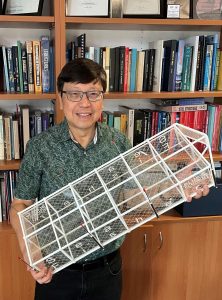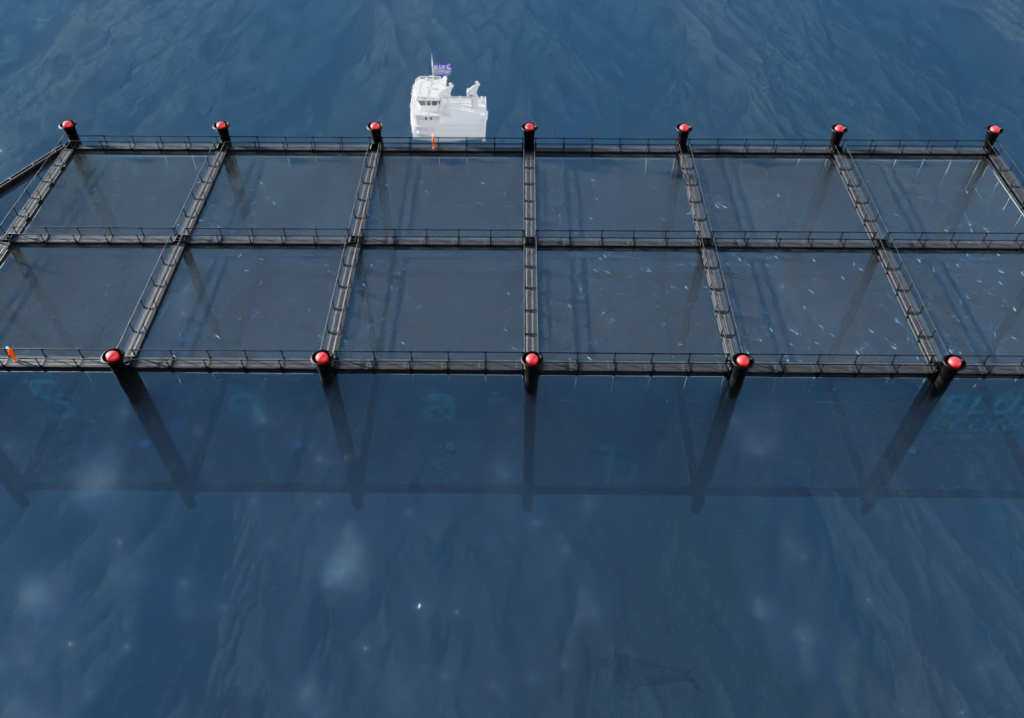Intensive fish farming is causing stress to coastal ecosystems, but a new offshore solution could turn the tide on how Australia produces seafood – while also improving the quality of the catch.
Australians’ love affair with salmon has spawned an expansion in fish farms along Tasmania‘s coastline, and the island’s precious environment and marine life are paying the price.
Waste and excess fish food impact local flora and fauna, not to mention the salmon, who are often given antibiotics to stave off disease. It’s a problem seen the world over as fisheries attempt to keep up with humanity’s insatiable appetite for seafood.
One Australian engineer has cast his net far and wide for a solution that keeps both our plates and the planet brimming with health. And it belongs beyond our coastlines, where the water is deeper, cooler and cleaner.

“There’s a lack of space near the shore, and farming over a long period of time stresses the whole ecosystem,” said Professor Chien Ming Wang of the University of Queensland’s School of Civil Engineering and Program Lead of the Blue Economy CRC Offshore Engineering and Technology program.
Wang said many fish farms would like to take their operations further offshore, but at this point they simply don’t have a cost-effective solution that enables them to do so.
“They want to feed the world sustainably but it needs to be financially viable,” he explained. “Offshore there’s more space, there’s more pristine water, and fish farming is very sustainable; it isn’t crowded like near-shore farming.”
A 2019 study of a major commercial fish farm off the coast of Panama led by scientists at the University of Miami backs this up. It found that commercially scaled offshore aquaculture installations, when appropriately sited, produced minimal environmental impacts to surrounding waters.
But designing an offshore fish pen isn’t small fry.
It must be large enough to cope with modern fish farm salmon volumes, robust enough to withstand the region’s strong ocean currents and harsh winds, and cost-effective enough to be financially viable.
At the same time, the pen must be able to operate on the surface – salmon need air, after all – and be secure, to ensure salmon do not escape into the wild.
Revolutionary piping
Wang’s answer is SeaFisher, a modular system of 20 m cubic cages constructed with strong but lightweight high-density polyethylene (HDPE).
“Our design is small, flexible, very simple and very elegant,” said Wang, who worked alongside researchers at Griffith University and the University of Tasmania, and with industry partners. “And I believe that it will be a game-changer for fish farming in the near future.”
The cages are linked two abreast to enable easy access for monitoring, feeding and harvesting the fish stock. A system of two-by-six cages would create a farm that’s 40 m wide, 120 m long and 20 m deep that could farm around 300,000 salmon.
Using HDPE piping is revolutionary, Wang explained, because it’s cheaper than steel (which has been used in previous fish pen designs), has excellent resistance to saltwater, and is resistant to corrosion.
To keep the pen and the fish safe from stormy surface waves, water pumps fill the pipes to submerge it to a depth of 20 m. When the danger’s passed, the ballast is emptied to enable the pen to rise to the surface again.
A front shield that diverts debris around the pen keeps SeaFisher clean while PET plastic netting keeps predators out. Plus the construction has minimal impact on the seabed, moored with a chain attached to a single suction anchor that allows it to move with water currents.
At an estimated initial cost of around $8 million, it’s also a fraction of the cost of other, more rigid offshore fish farming structures being used in the northern hemisphere, Wang said.
The world’s first fish farm, Ocean Farm 1, built in Qingdao in China and now located a couple of kilometres off the rugged Norwegian coast, can hold 1.5 million salmon in a floating mesh of wire and nets that’s as big as a soccer field. But it cost around US$300 million upfront, plus extra in licensing and maintenance.
“That’s very expensive for most fish farm operators,” Wang said. “SeaFisher is very, very affordable by comparison.”
Happier fish, happier oceans
While SeaFisher has been designed for farming salmon in offshore Tasmanian waters, Wang would like to see it adopted the world over.
“In near-shore farming, the design is very standard – a circular collar pad with a cylindrical net below it,” he said. “And it’s been used all over the world.
“When we move to offshore farming, we hope that SeaFisher will become the standard.”
Offshore farms will allow a step change increase in access to clean, cool deep water, and they’ll also produce better salmon, Wang added.
“Offshore fish are healthy facilitated by the stronger current and conditions that imitate wild environments. And also, the quality of the water column is better, so there are less stresses on the fish.
“Put simply, when fish are happier, they grow better.”
